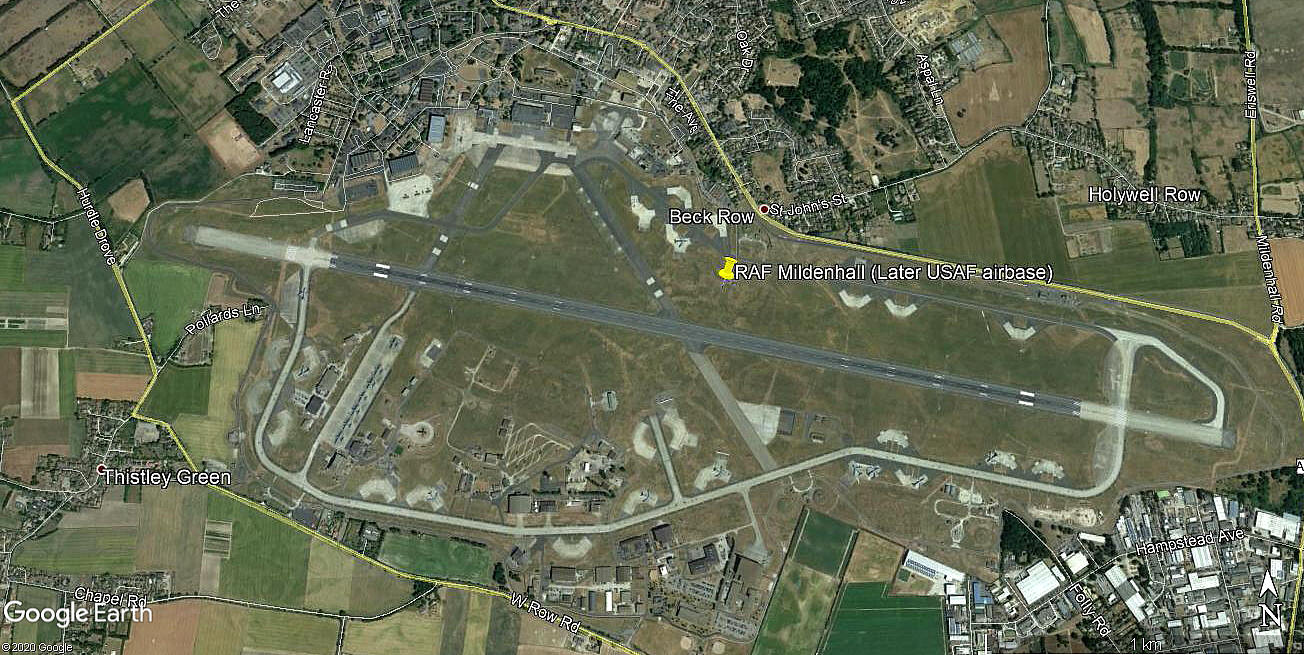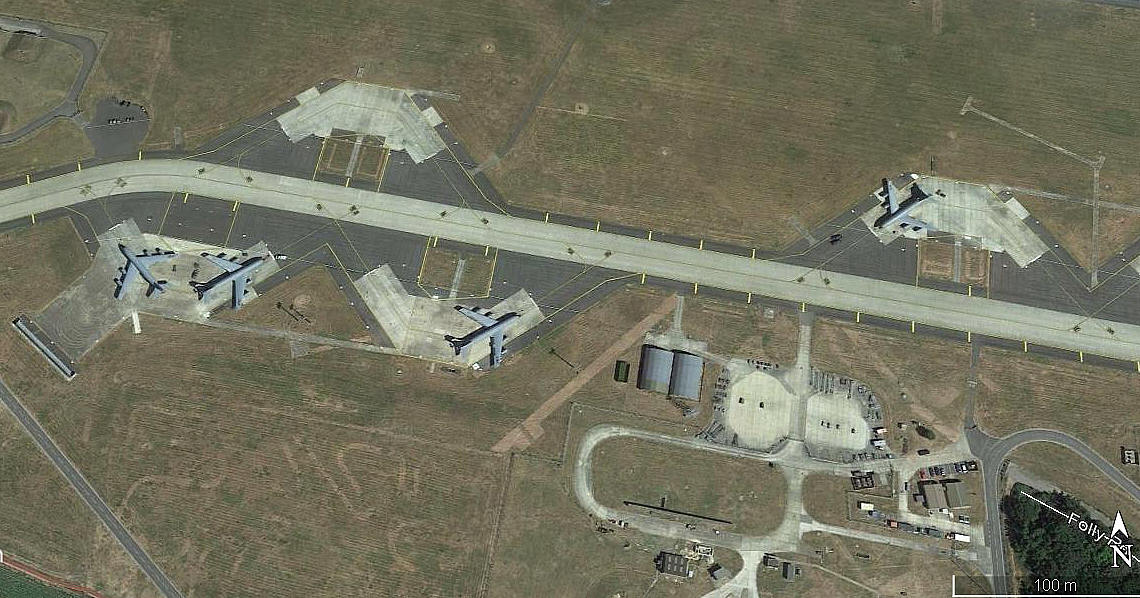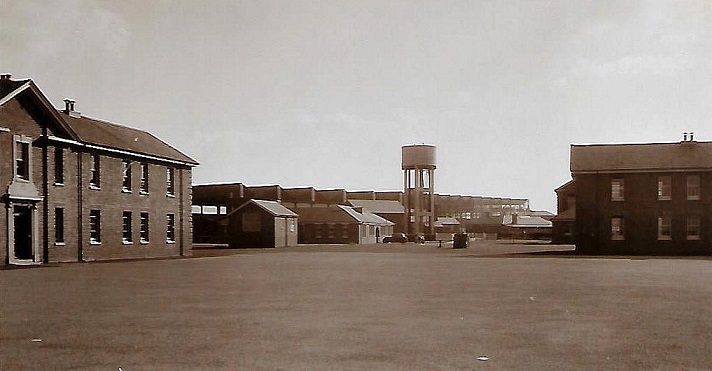Mildenhall
MILDENHALL: Military aerodrome allowing limited civil use in the 1930s
Note: All twelve of these pictures were obtained from Google Earth ©
MORE PICTURES
Note: Pictures by the author. Apart from the first picture the two others were taken in June 2015.
MAPS AND PICTURES
These four items were kindly provided by Mike Holder. The 1934 picture was published in Flight magazine on the 4th October 1934.
Military users: Interwar years: RAF Bomber Command 3 Group
38 Sqdn (Fairey Hendon Night Bombers)
99 & 149 Sqdns (Handley Page Heyfords & Vickers Wellingtons)
99 Sqdn (Wellingtons)
RAF Fighter Command 56 Sqdn (Take your pick, in the 1930s they flew; Armstrong-Whitworth Siskins, Bristol Bulldogs, Gloster Grebes, Gauntlets & Gladiators, any of which they might have been operating whilst based here?)
A MIKE CHARLTON GALLERY
Note: These pictures from postcards were kindly sent by Mike Charlton who has an amazing collection: See, www.aviationpostcard.co.uk
I could well be mistaken of course, but these pictures mostly appear to be from the mid 1930s, probably around the time the RAF Station opened in 1934. They certainly have the look of buildings that have been recently built and the lack of people, vehicles and aircraft are presumably another clue.
Fifth picture: I reckon the large bomber on the apron is a Handley Page Heyford and it looks like another is in the hangar. The type entered service with the RAF in 1934 so it may well be that these are brand spanking new. Two squadrons operated the type here - see above.
Sixth picture: This style of building is typical of the era when many new aerodromes were being constructed. It is a myth that the threat from Nazi Germany was not being realised. But why, I wonder, was a bland quasi-Georgian style of architecture favoured? Rather than a much more modern style reflecting the age of aviation? Perhaps they thought it reflected a more traditional approach, akin to 'Stately Homes' in some respects, whereby a sense of privilege could be conveyed to those entering such buildings.
Seventh picture: This picture of the main entrance shows the hangars still under construction. So presumably this was taken in 1933?
WW2: RAF Bomber Command 3 Group
15 Sqdn (Short Stirlings later Avro Lancasters)
99 & 115 Sqdns (Vickers Wellingtons)
149 Sqdn (Wellingtons, later Stirlings & Lancasters)
207 Sqdn (Lancasters later Avro Lincolns)
218 Sqdn (Bristol Blenheims)
419 (RCAF) Sqdn (Wellingtons)
622 Sqdn (Lancasters)
Note: The first image is from a CAA chart published in the 2000s. Second picture by the author.
Post 1945: RAF Bomber Command
3 Group Communications Flight (Avro Ansons)
44 Sqdn (Avro Lincolns)
149 Sqdn (Avro Lancasters later Lincolns)
207 Sqdn (Lincolns)
USAFE 100th Air Refuelling Wing
351st Air Refuelling Squadron
352nd Special Operations Group
7th, 21st and 67th Special Operations Squadrons
Types operating for example: (C-130 Hercules types, KC-135s and RC-135s)
US Naval Air Facility (C-12s)
10 ACCS (EC-135Hs)
1975: USAF C-130s and C-131s. USN C-131s, C-117Ds and C-1As
Location: S to SW of A1101 at Beck Row, NW of Mildenhall, 11nm NW of Bury St. Edmunds
Period of operation: 1934 to -
Runways: Originally ‘all-over’ grass (?)
WW2: 11/29 1829x46 hard 04/22 1280x46 hard
15/33 1280x46 hard
2000: 11/29 2812x61 hard
NOTES: According to some sources it appears that in 1932, 38 Sqdn were the first to operate the Fairey Hendon Night Bomber here, the first all-metal and low-wing monoplane operated by the RAF. Except it seems, the airfield didn’t open until 1934! Although the first flight of the Fairey Hendon was on the 25th November 1930 it obviously was a heavily flawed design? Seeing as it appears it didn’t enter service until 1936.
Further investigation reveals 38 Squadron, (originally a WW1 Squadron), was reformed in 1935 at MILDENHALL, initially equipped with the Handley Page Heyford before transferring to the Fairey Hendon in 1936 before moving to RAF MARHAM in 1938.
ANOTHER MIKE CHARLTON GALLERY
Mike very kindly sent me these pictures from postcards in early 2020. All, without any doubt taken as the airfield was being finished before opening in 1934.
THE GREAT MacROBERTSON RACE
This RAF Station opened on the 16th October 1934, just four days before the start of the MacRobertson London to Melbourne (Australia) air race, billed as “the world’s greatest air race” and quite rightly so it would seem. It was won by G-ACSS, the red DH.88 Comet Grosvenor House. In all 60 aircraft registered to enter the race but on the day only 20 lined up to compete. The two American airliners were expected to win so de Havilland “rushed through” the DH.88 in great secrecy in a desperate attempt to save the British reputation.
In fact the DH.88 Comet was specifically designed and built for this just this race and three of the type made competed. The selling price was £5000 and this was heavily subsided by de Havilland. However, once expenses were deducted – even from the £15,000 first prize, I don’t expect the winning team would have ended up with much in their pockets?
The competing Comets were:
G-ACSP Black Magic flown by Jim and Amy Mollison (neé Johnson)
G-ACSR flown by S/Ldr M McGregor and H C Walker,
G-ACSS (the winner) Grosvenor House flown by Flt Lt Charles Scott and Capt Tom Campbell Black.
Note: The Mollisons were in the lead for quite a while until, it is claimed, they burnt their engines out due to a lack of suitable fuel. In his excellent biography; Amy Johnson - Enigma in the Sky, David Luff quotes Flying Officer Jeffrey Quill, who went on to became one of the most respected British test pilots.
"I saw Jim and Amy climb into their Comet. He looked as white as a sheet and as if he had been sloshed for forty-eight hours - which I suspect he was. She looked very nervous and apprehensive and I felt desperately sorry for her having to climb in behind that raffish character for such a venture as this."
It was I suppose, by this point, that Jim Mollison was a total alcoholic, but, they landed at Baghdad ahead of the field; with amazing navigational accuracy despite encountering foul weather en route. This story is well worth reading up on.
Many years later I learnt that managing the mixture control was critical in the Comet, so it appears that, in all probability, this was the cause of their engines failing - not 'bad fuel'.
THE RACE FINISHERS
I think the list of finishers makes for interesting reading:
1st C-ACSS Grosvenor House de Havilland DH.88 Comet
2nd PH-AJU Uiver Douglas DC-2 (Entered by KLM)
3rd NR257Y Warner Bros. Comet Boeing 247D
Then; 4th G-ACSR DH.88 Comet, 5th ZK-ADJ Miles M.2F Hawk Major, 6th G-ACJL Airspeed AS.5 Courier, 7th VH-UQO DH.80 Puss Moth, 8th OY-DOD Desoutter Mk.II, and 9th ZK-ACO, a DH.89 Dragon Rapide. The winning Comet made a convincing win too, taking 70hr, 54min and 18 seconds. Quite why the seconds were important seems a mystery as the KLM DC-2 arrived after 90 hr 9min.
FLYING EAST
It is well worth reading the history of this race, with thrills and spills, adventures and tragic misfortune all along the way. I hadn’t realised this before but it does go to show that British designers and manufacturers were certainly dominating the field of entrants at that time. But, it would also seem that although Imperial Airways dominated the Far East route by sheer strength of numbers, (aircraft, crew, destinations etc), the ‘stars’ of the day were the KLM pilots with their super modern and fast Douglas DC-2s. Typically it seems the British government showed no interest in this race, ditto the Schneider Trophy etc.
Rather oddly perhaps (?) nor were the RAF. And yet throughout this period they backed a considerable number of record breaking flights. Here again, hindsight is a valuable commodity and I suppose those in the corridors of power could not see the value of breaking through design barriers which in turn could aid military advancements?
A QUESTION TO BE ASKED?
The question must surely be asked today about what impact, (if any?), the DH.88 Comet design had had within the de Havilland company ethos when the original design of the Mosquito was being considered? Some say it had a considerable influence, but I’d have thought the very aerodynamically advanced airliner design, the Albatross would have been of far greater influence?
A GHOST STORY
As pointed out elsewhere no ‘Guide’ on British flying sites would not be complete without a few ghost stories and the following from Military Ghosts by Alan C. Wood seems to be a pretty good example as it appears there were several witnesses: “One of the future squadrons destined to serve at Mildenhall were (sic) No.149 Squadron, formed on 3 March 1918, and equipped with F.E.2b biplane aircraft intended to be used as night bombers. The F.E.2b was one of the best fighters produced for the Air Force during the 1914-1919 war, and No.149 Squadron carried out night bombing attacks on German bases in occupied Belgium and northern France with great success.”
149 Squadron was formed at YAPTON, SUSSEX and the raids Mr Wood refers to were carried out when the squadron moved to France soon afterwards.
“On 12 April 1937, No.149 Squadron moved into Mildenhall equipped with Vickers Wellington Mark 1 twin-engined bombers (Second World War nickname ‘Wimpey’). The Second World War aerial war began slowly after 3 September, with desultory action by both the Royal Air Force and the recently formed German Luftwaffe. No.149 Squadron began to use its Wellingtons on day raids on the German Fleet and its harbours, and was the first squadron so to do.”
“On 18 December 1939, nine Wellingtons of 149 Squadron took off during daylight hours in a raid on Germany, intending to return under the protective cover of darkness. Two Wellingtons had to abort their mission due to engine trouble, which left seven heading for Germany. At 5.00 p.m., the Wellingtons began to return and land alongside the paraffin gooseneck flare-marked runway. Three landed safely in the gloom of night, but four were missing. At 5.30, the waiting ground staff heard the sound of a single aircraft engine; Wellingtons had twin engines, and one mechanic was heard to say, ‘That ain’t no Wimpey!’ In the light of the flickering gooseneck flares, the watching ground crew saw the incredible sight of a First World War F.E.2b biplane coming in over the airfield. The leather-helmeted pilot was clearly visible, as were his flying goggles and scarf. The watching ground staff saw a gloved hand reach out of the F.E.2b’s cockpit and throw something out: As he did so, the biplane increased speed, and flew low and fast out of sight.
The mechanics on the ground rushed to see what had been thrown out of the cockpit, and found a metal spanner with a hand-written note attached. The Duty Officer took the note. It read, ‘Wellington aircraft No. N2961, Squadron Code letters OJ=P, is down in the North Sea’.”
Well, is that spooky or what? I trust you will be able to sleep soundly tonight?
Mr Wood goes on to say; “Later, it was established that the Wellington N2961 had ditched in the sea, 40 miles off land; all the crew perished.” But he then goes on, as he often does in his book, with a quite remarkable assertion: “The pilot of the ghostly FE.2B had informed the Duty Officer that one of 149 Squadron’s aircraft was lost. The ghostly F.E.2B must have been flying with the Wellington N2961 when it ditched.” Quite how he reaches this conclusion escapes me. Is any other supporting evidence for this story known? With so many ‘witnesses’ I’m a bit surprised I hadn’t come across this story before. Being very picky indeed, it always bothers me, (or should I say very slightly intrigues me?), that somebody appearing to present a detailed account should refer to the F.E.2b as the F.E.2b, FE.2B and F.E.2B in the space of two paragraphs.
AN UTTERLY FUTILE RAID
Despite what you might have read above, which contains mistakes, on the 18th December 1939, a formation of twenty-four Wellingtons, led by Wing-Commander Richard Kellett of No.149 Squadron based here, set off across the North Sea to attack German navy vessels in Wilhelmshaven. Nine Wellingtons came from No.149 Squadron based here, nine from No.9 Squadron at HONINGTON and six Wellingtons from No.37 Squadron at FELTWELL.
Arriving in broad daylight with unlimited visibilty, Kellett had to abandon the raid, (not a bomb was dropped), because he could not guarantee that no civilians would be killed. Turning for home the Luftwaffe fighters laid into the formation, already scattered by flack, and of the twenty-two making the raid, (two had already turned back), only ten, all badly damaged, made it back.
For a fuller account please see my listing for FELTWELL.
THE SR.71 BLACKBIRD
Without much, if any doubt, the Blackbird was the ultimate spy plane, and never beaten. This said, satellite technology had pretty much rendered the type redundant. As far as I am aware, when based in the UK, I think it was only based here? For some information on the SR.71 I will quote, fittingly, from Taylor Downing in his excellent book Spies in the Sky. "The two-man crew who flew the Blackbird were more like astronauts wearing space suits and science fiction-like helmets than conventional pilots. The plane itself looked like an elegant, aerodynamic spear and it cut through the stratosphere like a knife through butter. Its six cameras could photograph a hundered thousand square miles of territory in an hour with sufficiently high resolution to read car registration number on the ground. It carried devices to jam anti-aircraft missiles that might be sent against it. The Blackbird brought back a wealth of information about Soviet nuclear capability, the location of its intercontinental ballistic missiles, its fighter bases and its bomber threat."
"In the October war in the Middle East in 1973, the Blackbird flew over the Arab countries assessing their military capabilities. The intelligence it gathered helped America in its negotiations for a ceasefire. During this war, in a single flight from the United States and back, with six mid-air refuelings, the Blackbird carried out a reconnaissance mission lasting 11 hours 20 minutes. Flying from Mildenhall in England, in April 1986, a Blackbird reconnaissance plane flew over Tripoli in Libya on a damage assessment flight following the American air raid on Colonel Gaddafi's headquarters.The Blackbird was the end of the line of fast, high altitude reconnaissance aircraft that had begun with the Spitfire and the Mosquito in 1940."
"It broke every record and still holds the official air speed record of 2194 mph, well above Mach 3. On one of its flights, in 1974, it flew from New York to London in an incredible 1 hour 54 minutes. Despite increasingly sophisticated radar controlled anti-aircraft missiles, not a single Blackbird was ever shot down."
We'd love to hear from you, so please scroll down to leave a comment!
Leave a comment ...
Copyright (c) UK Airfield Guide

















































